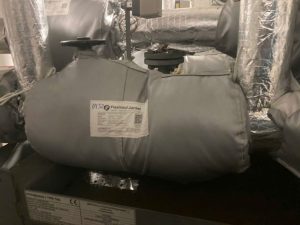Heat loss through piping systems is a leading cause of energy waste in factories and industrial plants. Pipe insulation jackets (also known as insulation bags or blankets) have emerged as a smart, flexible thermal solution that thoroughly addresses this issue, while also offering significant benefits in safety and operational efficiency.
What Are Pipe Insulation Jackets?
Pipe insulation jackets are multi-layered thermal systems, custom-designed and fabricated to fit the specific shapes of various components on a pipeline, such as valves, elbows, tees, expansion joints, flanges, or straight pipe sections.
The biggest difference compared to permanent insulation methods (like wrapping with mineral wool and then cladding with metal) is that insulation jackets can be easily removed and reused. This allows technicians to quickly access equipment for inspection, maintenance, or repair without having to destroy and reinstall the insulation layer, saving significant time and costs.
Construction and Operating Principle
A standard insulation jacket is composed of three layers of specialized materials that work together to optimize thermal insulation performance:
3-Layer Construction
- Outer Layer: This is the layer exposed to the environment, typically made from Silicone-coated fiberglass fabric, Teflon (PTFE), or Silica fabric. This layer’s function is to resist water, chemicals, abrasion, and UV rays.
- Insulation Core: The “heart” of the jacket, which determines its heat retention efficiency. Depending on the operating temperature, the core can be Ceramic Fiber, Glass Wool, Rockwool, or Aerogel for applications requiring extremely high performance.
- Inner Layer: This layer is in direct contact with the hot surface of the pipe and is usually made from fiberglass fabric or Silica fabric capable of withstanding high temperatures, ensuring the product’s durability.
Operating Principle
Insulation jackets work on the principle of preventing heat transfer. The porous, hollow core contains small air pockets, significantly reducing heat transfer by convection and conduction. The outer and inner layers form a sealed structure that blocks radiant heat and protects the core from external impacts.
Outstanding Benefits of Using Insulation Jackets
Investing in removable insulation jackets provides dual benefits in terms of economy and safety for any industrial system.
1. Reduce Heat Loss, Save Energy Costs
This is the most direct and significant benefit. Insulation jackets keep the temperature of the fluid (steam, oil, hot water) inside the pipes stable, reducing the load on boilers and heating systems, thereby helping businesses save a substantial amount on energy costs each month.
2. Ensure Worker Safety
The surface of steam pipes and hot oil pipes can reach several hundred degrees Celsius, posing a potential risk of severe burns. Covering them with insulation jackets helps lower the surface temperature to a safe level (usually below 60°C), creating a safer working environment for operators.
3. Protect and Extend Equipment Lifespan
An insulation jacket acts as a protective shield for pipes and fittings against impacts, chemical corrosion, and weather effects. Maintaining a stable temperature also helps reduce thermal stress, one of the causes of cracks and equipment failure.
4. Maximum Flexibility for Maintenance
Inspecting for leaks at flanges and valves becomes extremely simple. Just undo the straps, open the jacket, and reinstall it after the work is complete. Compared to cutting away and redoing permanent insulation, this solution saves up to 95% of the time and cost for each maintenance task.
Common Applications in Various Industries
Thanks to their flexibility and effectiveness, insulation jackets are widely used to insulate various types of pipes for steam, hot water, oil, and chemicals in many fields:
- Power plants, boilers: Insulating high-pressure steam lines, turbines, and control valves.
- Oil & Gas and Chemical industries: Insulating hot oil pipelines, chemical transport systems, and reactors.
- Food & Beverage processing: Maintaining temperature for steam sterilization lines and raw material transport pipes.
- Plastics, Rubber, and Textile industries: Insulating injection molding machines, extruders, and thermal oil pipelines.
- HVAC systems: Insulating chiller pipes and central hot water lines.
Guide to Choosing the Right Insulation Jackets
To select the optimal product, you need to provide the manufacturer with the following information:
- Operating Temperature: What is the maximum and continuous surface temperature of the pipe?
- Installation Environment: Is the equipment located indoors or outdoors? Will it be exposed to chemicals, oil, grease, or moisture?
- Size & Shape: Provide technical drawings or detailed measurements (diameter, length, type of valve/elbow/flange…) for precise fabrication.
- Special Requirements: Other needs such as fire resistance, sound insulation, or hygiene standards (for the food industry).
Equipping your piping system with insulation jackets is a smart, long-term investment. Contact reputable suppliers for consultation and to choose the most suitable solution for your plant.
Request consultation and quotation now!Frequently Asked Questions
What temperature can pipe insulation jackets withstand?
Depending on the core insulation material, jackets can withstand temperatures from -50°C to over 1200°C, meeting most industrial application requirements.
Is installing an insulation jacket complicated?
Not at all. Insulation jackets are designed with smart straps and fastening systems, allowing workers to install and remove them quickly by hand without specialized tools.
Are insulation jackets reusable?
Yes, this is their biggest advantage. You can remove them for maintenance and reinstall them multiple times throughout the product’s lifespan, leading to significant cost savings.
What is the average lifespan of an insulation jacket?
The lifespan of an insulation jacket typically lasts for many years, depending on the material quality and operating environment. High-quality products can last for over 5-10 years.
Which is better: removable insulation jackets or permanent insulation?
Removable insulation jackets are superior in terms of flexibility, reusability, and maintenance convenience. Permanent insulation may have a lower initial cost for long, straight pipe sections but becomes more expensive when repairs are needed.










